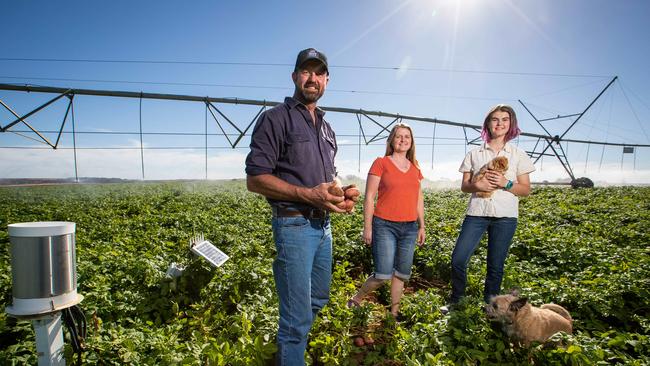Forget pollies, let soil do the talking on water
All along the Murray River, water is scarce, precious, and very expensive.

All along the Murray River, right down to near its mouth in South Australia, water is scarce, precious, and very expensive.
It’s also very controversial, driving a rebellion against the Nationals in the NSW state election and looming as a major issue in the federal poll. For some farmers the answer may lie in new technologies rather than in politics.
With the drought meaning the cost of watering his potato crop has risen from $50-$110 per megalitre in a normal year to $500 now, farmer Aaron Haby cannot afford any margin of error on when to irrigate.
“It’s a very dry climate,” Mr Haby said from his property, Forster Hill, which borders the Murray about 100km east of Adelaide. “We haven’t seen rain for a long time.”
Yesterday, the Murray-Darling Basin Authority issued a dire report saying that high demand, low inflows, drought, and hot conditions had led to higher-than-average losses of water.
Mr Haby is descended from German settlers who came to South Australia a century ago, and is the third generation of his family farming in the district. He grows potatoes, onions, and legumes in the sandy riverland soil and runs merino sheep with his wife, Elizabeth, daughter Chelsea, and parents Phillip and Yvonne.
Leading-edge technology that is being tested on his farm is enabling him to use water more cost effectively. “That’s always the plan — grow a bigger crop with less water,” Mr Haby said.
Forster Hill, covering 3500ha, is the venue for a trial developed by University of South Australia commerce lecturer Joanne Tingey-Holyoak, and Adelaide technology company Sentek.
Dr Tingey-Holyoak will present the early results of the trial at the UniSA Business School National Water Forum today.
One element of the project involves soil probes, which go down to root level and measure soil moisture, salinity and temperature. Field gauges record rainfall, while a weather station supplies wind speed and direction and temperature. An irrigation flow meter records when and how much water is used.
All that information from the field is fed every few minutes from a wireless data transmission unit to software in the cloud, and from there to either the mobile phone or home computer of the farmer.
“Wherever there’s internet access, he or she can watch what is going on right now in the field,” Sentek co-founder Peter Buss said. The software uses complex algorithms to integrate the field information with financial data to assess the real cost and benefit of irrigating, including water prices, electricity usage for pumping, and labour.
Once, when Mr Haby bought and used an Olympic pool-sized volume of water worth $1000, the air temperature was so high and the wind so great that it largely evaporated rather than soaking into the soil, and the soil sensors detected that. “Two megalitres of water was being applied to the land, but it wasn’t having any effect on the growth of the plant, it wasn’t getting enough to drink,” Dr Tingey-Holyoak said.
Mr Buss said it would be two or three years before Sentek had a commercial product. But Mr Haby is already a fan. “Just to have that extra tool in the toolbox to work out when to irrigate and when not to is invaluable,’’ he said.



To join the conversation, please log in. Don't have an account? Register
Join the conversation, you are commenting as Logout